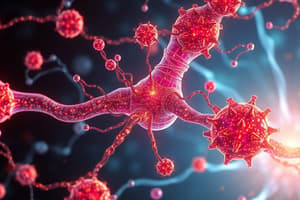Podcast
Questions and Answers
What is a significant difference between Physostigmine and Neostigmine regarding their source?
What is a significant difference between Physostigmine and Neostigmine regarding their source?
Which of the following pharmacologic actions is not associated with Physostigmine?
Which of the following pharmacologic actions is not associated with Physostigmine?
What is the primary mechanism by which Physostigmine produces miosis in the eye?
What is the primary mechanism by which Physostigmine produces miosis in the eye?
What is a common therapeutic use for Neostigmine?
What is a common therapeutic use for Neostigmine?
Signup and view all the answers
What type of compound is Physostigmine classified as?
What type of compound is Physostigmine classified as?
Signup and view all the answers
What is the role of pralidoxime in relation to organophosphate poisoning?
What is the role of pralidoxime in relation to organophosphate poisoning?
Signup and view all the answers
Why is it important to administer pralidoxime quickly after organophosphate exposure?
Why is it important to administer pralidoxime quickly after organophosphate exposure?
Signup and view all the answers
Which of the following is not a special effect of Physostigmine on the eye?
Which of the following is not a special effect of Physostigmine on the eye?
Signup and view all the answers
What mechanism leads to the miosis effect of Physostigmine on the eye?
What mechanism leads to the miosis effect of Physostigmine on the eye?
Signup and view all the answers
What is a main therapeutic application of Neostigmine?
What is a main therapeutic application of Neostigmine?
Signup and view all the answers
Which characteristic differentiates Physostigmine from Neostigmine in terms of lipid barrier penetration?
Which characteristic differentiates Physostigmine from Neostigmine in terms of lipid barrier penetration?
Signup and view all the answers
What is the primary source of Physostigmine?
What is the primary source of Physostigmine?
Signup and view all the answers
What effect does Physostigmine have on the gastrointestinal tract?
What effect does Physostigmine have on the gastrointestinal tract?
Signup and view all the answers
Pralidoxime is most effective when administered within what timeframe after organophosphate exposure?
Pralidoxime is most effective when administered within what timeframe after organophosphate exposure?
Signup and view all the answers
Which of the following effects is NOT associated with Neostigmine?
Which of the following effects is NOT associated with Neostigmine?
Signup and view all the answers
How does Physostigmine assist in postoperative urinary retention?
How does Physostigmine assist in postoperative urinary retention?
Signup and view all the answers
Flashcards
Physostigmine (Eserine)
Physostigmine (Eserine)
A natural plant alkaloid that inhibits acetylcholinesterase (AChE), leading to increased acetylcholine levels at various sites, causing muscarinic, nicotinic, and central nervous system (CNS) effects. It can cross the blood-brain barrier.
Neostigmine
Neostigmine
A synthetic drug that inhibits acetylcholinesterase (AChE) and is used to increase acetylcholine levels. Unlike physostigmine, it does not readily cross the blood-brain barrier.
Pralidoxime
Pralidoxime
A drug that specifically reactivates cholinesterase enzymes that have been inhibited by organophosphate poisons, like those found in pesticides. It works by breaking the bond between the organophosphate and the enzyme.
Penetration of Lipid Barriers
Penetration of Lipid Barriers
Signup and view all the flashcards
Cholinergic Action
Cholinergic Action
Signup and view all the flashcards
Muscarinic Action
Muscarinic Action
Signup and view all the flashcards
Nicotinic Action
Nicotinic Action
Signup and view all the flashcards
Anticonvulsants
Anticonvulsants
Signup and view all the flashcards
Acetylcholinesterase inhibitor (AChEI)
Acetylcholinesterase inhibitor (AChEI)
Signup and view all the flashcards
Blood-brain barrier penetration
Blood-brain barrier penetration
Signup and view all the flashcards
Study Notes
Physostigmine (Eserine) and Neostigmine
- Physostigmine (Eserine): Natural plant alkaloid, tertiary amine, good absorption
- Neostigmine: Synthetic, quaternary ammonium compound, poor and irregular absorption
- CNS Penetration:
- Physostigmine: Crosses the blood-brain barrier, stimulating the CNS
- Neostigmine: Does not cross the blood-brain barrier
- Mechanism of Action: Both inhibit acetylcholinesterase (AChE), leading to acetylcholine accumulation, producing:
- Muscarinic effects: More pronounced on the gastrointestinal tract (GIT) and urinary bladder
- Nicotinic effects
- CNS stimulation (Physostigmine only)
- Peripheral actions: AChEI and direct stimulant action on skeletal muscle.
- Special Effects (Physostigmine):
- Eye: Miosis (constriction of pupils), decreased intraocular pressure (IOP), ciliary muscle contraction (for near vision), lacrimation.
- Action on Skeletal Muscle:
- Stimulation via AChE inhibition at the myoneural junction
- Direct stimulant action
- Therapeutic Uses (Physostigmine):
- Glaucoma treatment (less common now)
- Antidote to atropine overdose (or other antimuscarinic drugs)
- Stimulate GIT and bladder (e.g., paralytic ileus, post-operative urinary retention)
- Therapeutic Uses (Neostigmine):
- Myasthenia gravis management (with atropine to block muscarinic receptors)
- Antidote for competitive neuromuscular-blocking agents (NMBs)
Pralidoxime
- Use: Regenerate cholinesterase after organophosphate poisoning by breaking the phosphorus bond.
- Importance of Timing: Must be administered as soon as possible after exposure (ideally within 12 hours) due to "aging" of the enzyme.
- Mechanism: High affinity for phosphorus, enabling it to regenerate the enzyme.
Anticonvulsants
- Example: Diazepam
Studying That Suits You
Use AI to generate personalized quizzes and flashcards to suit your learning preferences.
Description
This quiz explores the pharmacological properties of Physostigmine and Neostigmine, including their absorption, CNS penetration, and mechanisms of action. Understand the distinctions between these two compounds and their effects on the autonomic nervous system and skeletal muscle.



